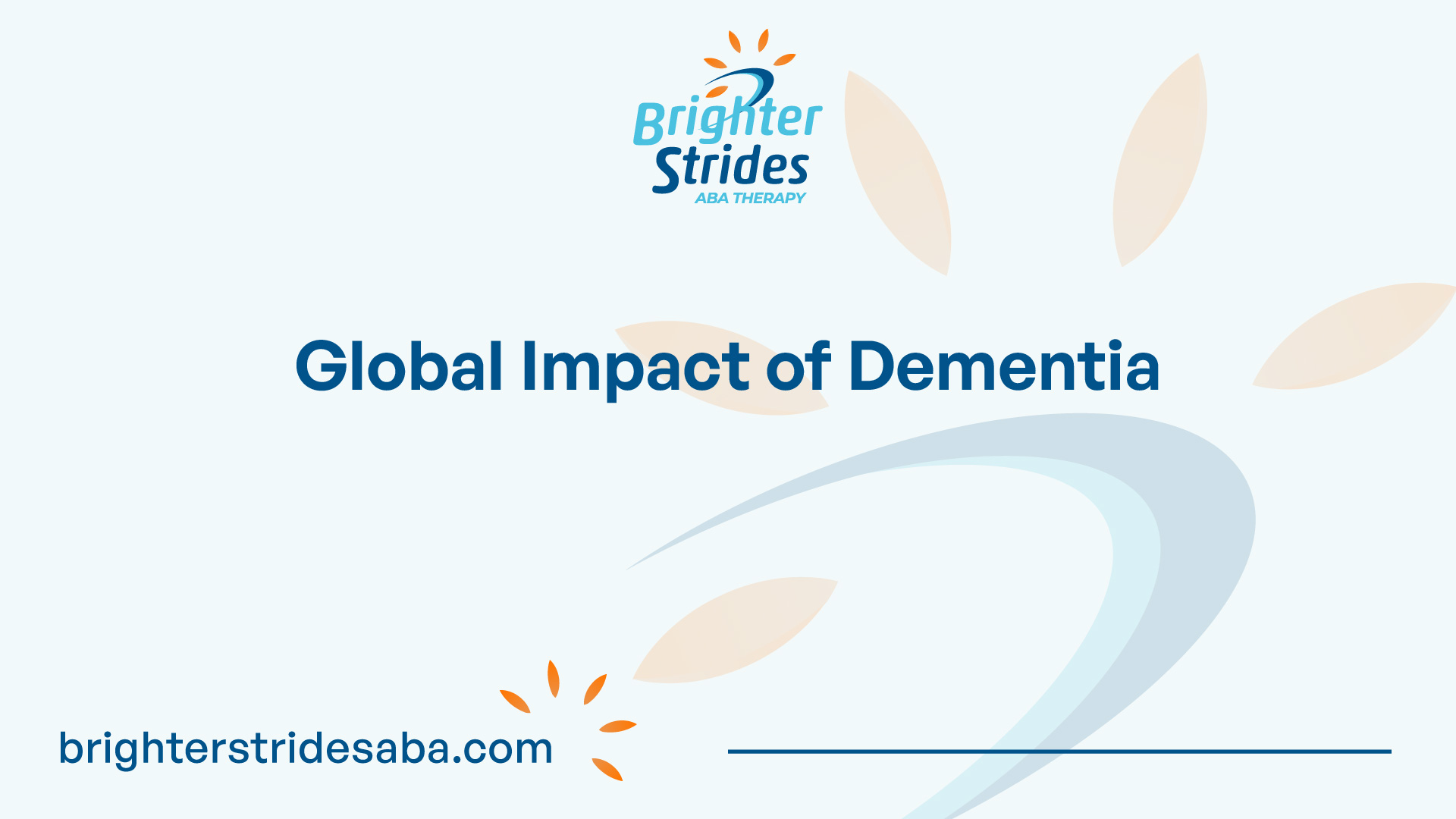Top 10 Dementia Statistics
- 55 million people worldwide live with dementia
- A new case of dementia occurs every 3 seconds globally
- Alzheimer’s disease accounts for 60-70% of dementia cases
- The global cost of dementia is estimated at $1.3 trillion annually
- Women are more likely to develop dementia than men
- By 2050, dementia cases are projected to reach 139 million
- Only 1 in 4 people with dementia receive a formal diagnosis
- Dementia is the 7th leading cause of death worldwide
- 1 in 3 seniors dies with Alzheimer’s or another dementia
- The risk of dementia doubles every 5 years after age 65

Understanding Dementia
To unravel the statistics and facts surrounding dementia, it’s important to have a clear understanding of this syndrome and its various forms. Dementia is a syndrome that can be caused by a number of diseases, which over time destroy nerve cells and damage the brain. This typically leads to a deterioration in cognitive function beyond what might be expected from the usual consequences of biological aging. While consciousness is not affected, cognitive impairment is commonly accompanied by changes in mood, emotional control, behavior, or motivation [1].
Dementia Overview
Alzheimer’s disease is the most common form of dementia, accounting for approximately 60-70% of cases. Other forms of dementia include vascular dementia, dementia with Lewy bodies, and a group of diseases that contribute to frontotemporal dementia [1]. Dementia is not a normal part of aging, but age is the strongest known risk factor. As individuals age, the risk of developing dementia increases. However, it’s important to note that dementia can also affect individuals under the age of 65, known as young-onset dementia [2].
Types of Dementia
Understanding the different types of dementia can provide further insights into this complex condition. Here are some of the main forms of dementia:
- Alzheimer’s Disease: Alzheimer’s disease is the most prevalent form of dementia, contributing to approximately 60-70% of cases. It is characterized by the accumulation of amyloid plaques and neurofibrillary tangles in the brain, leading to the progressive degeneration of cognitive function.
- Vascular Dementia: Vascular dementia is caused by impaired blood flow to the brain, typically resulting from stroke or other vascular conditions. This form of dementia is associated with difficulties in thinking, reasoning, and memory.
- Dementia with Lewy Bodies: Dementia with Lewy bodies is characterized by abnormal protein deposits in the brain called Lewy bodies. People with this form of dementia may experience visual hallucinations, fluctuations in attention and alertness, and motor symptoms similar to Parkinson’s disease.
- Frontotemporal Dementia: Frontotemporal dementia is a group of disorders that affect the frontal and temporal lobes of the brain. This form of dementia is associated with changes in personality, behavior, and language.
Understanding the different types of dementia is crucial for accurate diagnosis and appropriate treatment. Each form of dementia presents unique challenges and may require tailored approaches to care and support. For more information on the global impact of dementia, including statistics and costs, continue reading our article on Dementia Statistics Worldwide and Cost of Dementia Care.
Global Impact of Dementia
Dementia is a worldwide health concern, with significant implications for individuals, families, and societies. Let’s explore the global impact of dementia by examining the statistics and the cost of dementia care.

Dementia Statistics Worldwide
Dementia is a growing problem around the globe. According to Alzheimer’s Disease International, someone in the world develops dementia every 3 seconds. In 2020, there were over 55 million people worldwide living with dementia. This number is projected to nearly double every 20 years, reaching 78 million in 2030 and a staggering 139 million in 2050.
It is important to note that much of this increase will occur in developing countries. Currently, 60% of people with dementia live in low and middle-income countries, but this is expected to rise to 71% by 2050. The most rapid growth in the elderly population is occurring in China, India, and their South Asian and Western Pacific neighbors.
Each year, there are over 10 million new cases of dementia worldwide, which equates to one new case every 3.2 seconds. These statistics highlight the urgent need for increased awareness, research, and support for individuals and communities affected by dementia.
Cost of Dementia Care
The economic impact of dementia is substantial. In 2015, the estimated worldwide cost of dementia was US$ 818 billion, equivalent to 1.09% of global GDP at that time. However, the annual global cost of dementia has now surpassed US$ 1.3 trillion and is projected to rise to US$ 2.8 trillion by 2030. These figures, provided by Alzheimer’s Disease International, underscore the financial burden associated with dementia care.
The costs of dementia encompass various aspects. Direct medical care costs account for approximately 20% of the global dementia costs, while direct social sector costs and informal care costs each account for around 40%. The contribution of informal care is most significant in African regions and lowest in North America, Western Europe, and some South American regions. Conversely, social sector costs have a greater impact in these latter regions.
In the United States alone, the combined medical and caregiving costs associated with the care of all individuals with Alzheimer’s dementia were estimated to exceed $500 billion in 2020. This amount is projected to rise to a staggering $1.6 trillion by 2050. Out-of-pocket and caregiving costs are particularly high in the last year of life among community dwelling persons living with dementia, accounting for just over 50% of total expenditures.
These statistics highlight the immense financial burden on individuals, families, and healthcare systems due to dementia. Addressing the economic impact of dementia is crucial for ensuring accessible and sustainable care for those affected by this condition.
Understanding the global impact of dementia is essential for policymakers, healthcare professionals, and society as a whole. By raising awareness and investing in research and support, we can work towards improving the lives of individuals living with dementia and their caregivers.
Risk Factors and Prevention
Understanding the risk factors associated with dementia is essential for implementing preventive measures. While some risk factors for dementia cannot be modified, there are several modifiable risk factors that individuals can address to reduce their risk. Additionally, lifestyle factors such as exercise and diet play a crucial role in dementia prevention.

Modifiable Risk Factors
Research suggests that approximately 40% of dementia cases may be attributed to twelve key modifiable risk factors. These factors include:
- High blood pressure
- Smoking
- Diabetes
- Obesity
- Lack of physical activity
- Poor diet
- High alcohol consumption
- Low levels of cognitive engagement
- Depression
- Traumatic brain injury
- Falls
- Social isolation
- Air pollution
Addressing these risk factors through lifestyle changes and appropriate medical interventions can potentially reduce the risk of developing dementia.
Role of Exercise and Diet
Engaging in regular physical activity and adopting a healthy diet are crucial components in reducing the risk of cognitive decline and dementia. Studies have shown that individuals can lower their risk by:
- Being physically active
- Not smoking
- Avoiding harmful alcohol consumption
- Controlling weight
- Eating a healthy diet
- Maintaining healthy blood pressure, cholesterol, and blood sugar levels
Regular exercise can lead to improved strength, balance, cardiovascular health, and may help manage symptoms associated with dementia, such as restlessness. It is increasingly evident that exercise, when combined with a healthy diet and treatment of cardiovascular disease risk factors, can contribute to brain protection against dementia.
By adopting a physically active lifestyle and consuming a nutritious diet, individuals can take proactive steps towards reducing their risk of dementia. It is important to consult with healthcare professionals for personalized advice on exercise and dietary choices.
Reducing the risk of dementia is crucial for maintaining cognitive health. While age is a significant risk factor, it’s important to note that dementia is not a normal part of aging. Older adults with higher levels of education also tend to have a lower risk of developing dementia. In 2019, only 5% of older college graduates (ages 70 and older) were living with dementia, compared to 18% of those with less than 12 years of education.
By addressing modifiable risk factors and adopting a healthy lifestyle that includes regular exercise and a balanced diet, individuals can take proactive steps towards reducing their risk of dementia and promoting overall brain health.
Diagnosis and Treatment
When it comes to diagnosing and treating dementia, a comprehensive approach is essential. No single test can diagnose dementia, and a combination of diagnostic procedures is typically required to pinpoint the problem. These procedures may include cognitive and neuropsychological tests, neurological evaluation, brain scans, laboratory tests, and psychiatric evaluation, among others [4].
Diagnostic Procedures
To accurately diagnose dementia, healthcare professionals rely on various diagnostic procedures. These procedures help evaluate cognitive function, rule out other potential causes of symptoms, and determine the underlying cause of dementia. Common diagnostic procedures include:
- Cognitive and neuropsychological tests: These assessments evaluate memory, thinking skills, language abilities, and other cognitive functions. They help identify the extent and pattern of cognitive decline.
- Neurological evaluation: A neurological examination assesses reflexes, muscle strength, coordination, and sensory function. It helps identify any neurological abnormalities associated with dementia.
- Brain scans: Imaging techniques such as magnetic resonance imaging (MRI) and positron emission tomography (PET) scans can provide detailed images of the brain. These scans help detect structural abnormalities, such as shrinkage or the presence of brain lesions.
- Laboratory tests: Blood tests may be conducted to rule out other conditions that can cause similar symptoms. These tests can help identify underlying metabolic, hormonal, or nutritional imbalances.
- Psychiatric evaluation: A psychiatric evaluation helps assess mental health and rule out other psychiatric conditions that may contribute to cognitive impairment.
It’s important to note that early and accurate diagnosis of dementia is crucial for implementing appropriate treatment strategies and providing support to individuals and their families.
Medications and Therapies
While there is no cure for most types of dementia, medications and therapies can help manage symptoms and improve quality of life. The choice of treatment depends on the specific type and stage of dementia. Common medications and therapies used in the treatment of dementia include:
- Cholinesterase inhibitors: Medications such as donepezil, rivastigmine, and galantamine are cholinesterase inhibitors that can temporarily improve cognitive symptoms in some individuals with dementia. These medications work by increasing the levels of acetylcholine, a chemical messenger involved in memory and learning [4].
- Memantine: Memantine is another medication used to treat moderate to severe Alzheimer’s disease. It works by regulating glutamate, a chemical messenger involved in brain functions such as learning and memory.
- Therapies: Non-pharmacological therapies play a crucial role in managing dementia symptoms. These may include cognitive stimulation therapy, reality orientation, reminiscence therapy, and occupational therapy. These therapies aim to enhance cognitive function, improve communication skills, manage behavioral changes, and promote overall well-being.
- Lifestyle modifications: Lifestyle modifications, including regular exercise and a healthy diet, may help slow the progression of dementia and improve overall brain health. Exercise can improve strength, balance, cardiovascular health, and may help alleviate symptoms such as restlessness. A healthy diet, combined with exercise and treatment of cardiovascular risk factors, may protect the brain from dementia [4].
As research continues, new diagnostic procedures, medications, and therapies are being explored to improve the diagnosis and treatment of dementia. Early detection and a comprehensive treatment plan can help individuals with dementia maintain a higher quality of life for as long as possible.
Dementia Trends in the U.S.
Understanding the trends and statistics related to dementia in the United States is crucial for developing strategies and support systems to address the challenges faced by individuals and their families. In this section, we will explore the latest U.S. dementia statistics and shed light on racial and gender disparities associated with dementia.
U.S. Dementia Statistics
The prevalence of dementia among adults ages 70 and older in the United States has shown a decline from 13% in 2011 to 10% in 2019. However, due to the aging baby boomer population, the total number of people with dementia is projected to rise significantly. In 2020, estimates suggest that over 7 million people aged 65 or older in the U.S. have dementia, and this number is expected to exceed 9 million by 2030 and nearly 12 million by 2040 [5].
It is worth noting that the prevalence of dementia varies with age. In 2019, approximately 3% of adults ages 70 to 74 had dementia, while the prevalence increased to 22% among adults ages 85 to 89 and 33% among adults ages 90 and older. Women are slightly more likely to have dementia compared to men, and there are also disparities among different racial and ethnic groups, as we will discuss in the next section.
Racial and Gender Disparities
When examining racial and gender disparities in dementia, non-Hispanic white adults have lower rates of dementia compared to non-Hispanic Black and Hispanic adults. This highlights the importance of considering cultural and ethnic factors that may contribute to these disparities. The reasons behind these differences are complex and may be influenced by a combination of genetic, socioeconomic, and environmental factors [5].
Additionally, educational attainment plays a role in dementia prevalence. Older adults with higher levels of education are less likely to develop dementia. In 2019, 5% of older college graduates (ages 70 and older) were living with dementia, compared to 18% of those with less than 12 years of education. This suggests that education may have a protective effect against dementia [5].
Understanding the trends and disparities in dementia prevalence helps to inform public health initiatives and targeted interventions aimed at reducing the burden of dementia. By addressing modifiable risk factors and promoting education, awareness, and access to appropriate healthcare, we can strive to improve the lives of individuals affected by dementia and their families.
Economic Impact of Dementia
Dementia not only takes a toll on individuals and their families but also has significant economic implications. Understanding the cost of dementia care is essential for policymakers, healthcare providers, and society as a whole. In this section, we will explore the cost of dementia care in the U.S. and economic projections related to this debilitating condition.
Cost of Dementia Care in the U.S.
The estimated cost of dementia care in the United States was a staggering $305 billion in 2020 [5]. Families bear the majority of the monetary burden, with out-of-pocket costs for older people with dementia being over 80% higher than for those without dementia in the last five years of life. These costs include medical care, long-term care, and other related expenses.
To put these numbers into perspective, it is projected that the cost of dementia care in the U.S. will rise to a staggering $1.5 trillion by 2050 [5]. This exponential increase highlights the urgent need for effective prevention strategies, improved access to quality care, and enhanced support systems.
Economic Projections for Dementia
Globally, dementia poses a significant economic burden. The total estimated worldwide cost of dementia was $818 billion in 2015, representing 1.09% of global GDP at that time. However, this figure has continued to rise, and the annual global cost of dementia is now above $1.3 trillion. Projections indicate that it will further increase to $2.8 trillion by 2030 [6].
When examining the breakdown of these costs, roughly 20% can be attributed to direct medical care, while direct social sector costs and informal care costs each account for approximately 40% [6]. It is important to note that the relative contribution of informal care is highest in African regions and lowest in North America, Western Europe, and some South American regions, while the reverse is true for social sector costs.
In the United States, the combined medical and caregiving costs associated with caring for individuals with Alzheimer’s dementia were estimated to exceed $500 billion in 2020. These costs are projected to rise to a staggering $1.6 trillion by 2050. Notably, out-of-pocket and caregiving costs are particularly high in the last year of life among community-dwelling individuals living with dementia, accounting for just over 50% of total expenditures.
The economic impact of dementia varies across the continuum of the disease and demographic characteristics such as race, ethnicity, and living arrangement. For example, in the case of U.S. Latinos aged 65 and older living with dementia, it is projected that the direct costs (medical plus long-term care) will be $169.1 billion by 2060, representing a 24-fold increase from costs in 2012.
These economic projections highlight the urgent need for increased investment in dementia research, innovative care models, and support services. By addressing the economic impact of dementia, we can work towards better outcomes for individuals living with this condition and their families.
References
- https://www.who.int/news-room/fact-sheets/detail/dementia
- https://alzheimer.ca/en/about-dementia/how-can-i-reduce-risk-dementia/risk-factors-dementia
- https://www.ncbi.nlm.nih.gov/pmc/articles/PMC8608182/
- https://www.mayoclinic.org/diseases-conditions/dementia/diagnosis-treatment/drc-20352019
- https://www.prb.org/resources/fact-sheet-u-s-dementia-trends/
- https://www.alzint.org/about/dementia-facts-figures/dementia-statistics/

 We've just released an article!
Check out our blog!
We've just released an article!
Check out our blog!



